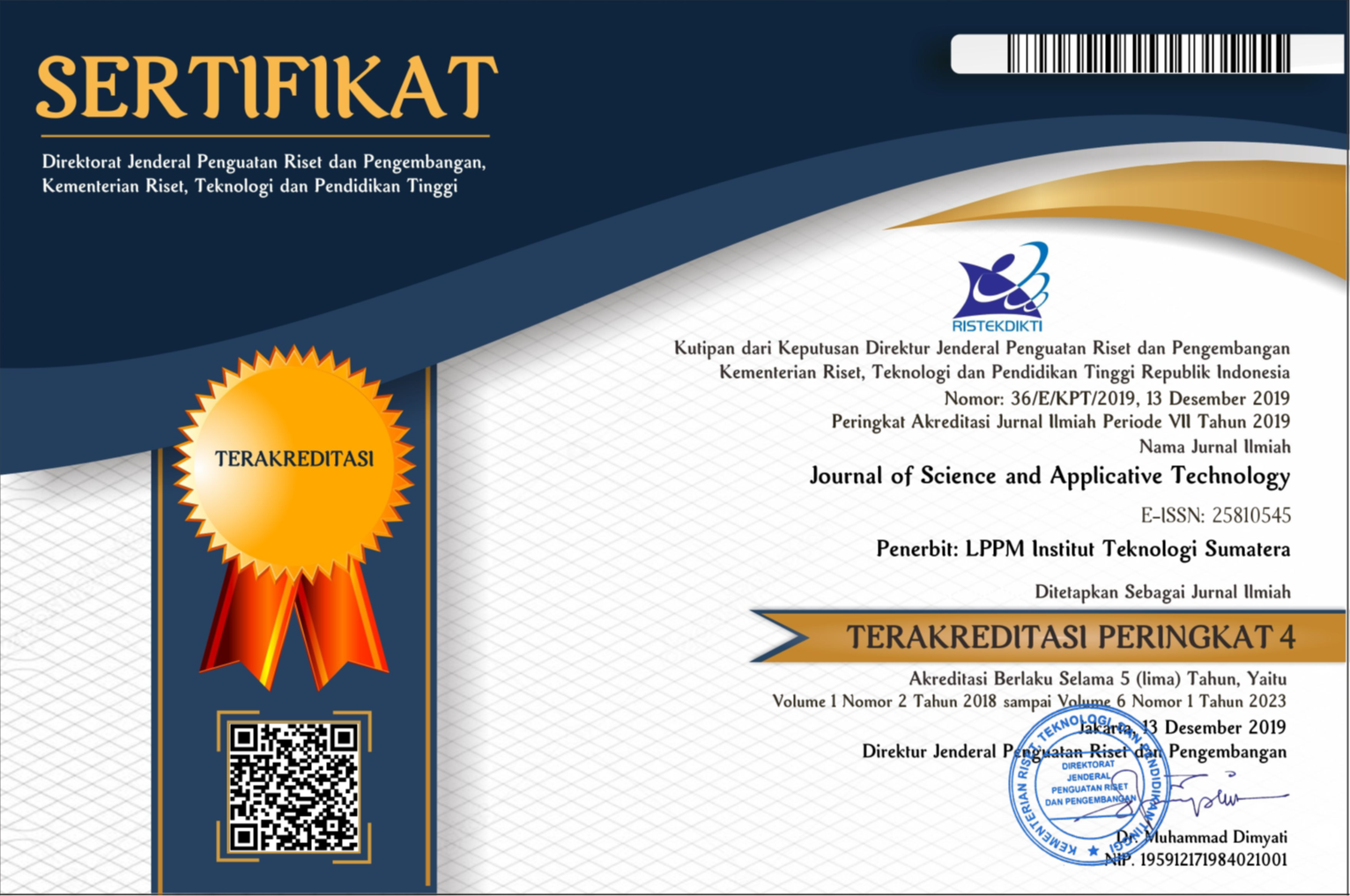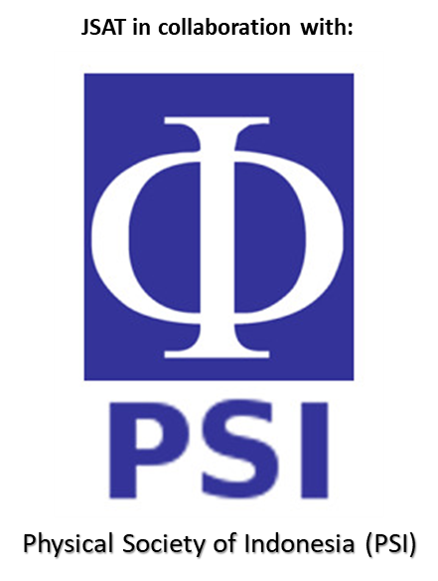Acoustic CO2 Gas Sensor Based on Phase Difference Measurement
Abstract
In this research, an acoustic sensor has been successfully built to measure the concentration of CO2 gas in a mixture of gases (N2 and CO2). The nitrogen and carbon dioxide gases used are ultra-high purity (UHP) gas. The measurement parameter used is the speed of sound by utilizing the phase shift between ultrasonic wave signals that are sent and received continuously. The acoustic method in this research is by using the speaker as an ultrasonic wave transmitter, and the microphone as an ultrasonic wave receiver emitted by the speaker on the gas medium. This acoustic phase shift method is very sensitive to be used to determine the speed of sound on a gas medium. From the sensor testing, the sensor has good linearity in detecting changes in CO2 concentration in the gas mixture. The sensor test results have been validated theoretically and obtained an RMS error of 3.36 (3.36% with a maximum concentration of 100%), this proves that the work of the sensor is in accordance with the theory. In addition to theoretical validation, the work of the sensor has also been validated by looking at the direct relationship between sensor input and output through the inverse function, and an RMS error of 3.51 (3.51% with a maximum concentration of 100%) is obtained. From the overall results obtained, the acoustic CO2 gas sensor that is built can detect changes in CO2 concentrations in the gas mixture accurately, fabrication of the sensor is easy to do, and the costs required in the manufacturing process are cheap.
Downloads
References
[2] O. US EPA, “Overview of Greenhouse Gases,” 2016.
[3] P. Driessen, “Carbon Dioxide: The Gas of Life Tiny amounts of this miracle molecule make life on Earth possible A Special Report for the Committee For A Constructive Tomorrow PROSPERING LIVES PROMOTING PROGRESS PROTECTING THE EARTH PROVIDING EDUCATION Carbon Diox,” 2013.
[4] O. Oter, K. Ertekin, D. Topkaya, and S. Alp, “Room temperature ionic liquids as optical sensor matrix materials for gaseous and dissolved CO2,” Sensors Actuators B Chem., vol. 117, no. 1, pp. 295–301, Sep. 2006.
[5] “Earth’s CO2 Home Page.” [Online]. Available: https://www.co2.earth/. [Accessed: 27-Aug-2019].
[6] D. Gibson and C. Macgregor, “A Novel Solid State Non-Dispersive Infrared CO2 Gas Sensor Compatible with Wireless and Portable Deployment,” Sensors, vol. 13, pp. 7079–7103, 2013.
[7] J. M. Daisey, W. J. Angell, and M. G. Apte, “Indoor air quality, ventilation and health symptoms in schools: an analysis of existing information.,” Indoor Air, vol. 13, no. 1, pp. 53–64, Mar. 2003.
[8] S.-F. Ferng and L.-W. Lee, “Indoor air quality assessment of daycare facilities with carbon dioxide, temperature, and humidity as indicators.,” J. Environ. Health, vol. 65, no. 4, pp. 14–18, 22, Nov. 2002.
[9] M. G. Apte, “A Review of Demand Control Ventilation,” 2006.
[10] G. Zhang, Y. Li, and Q. Li, “A miniaturized carbon dioxide gas sensor based on infrared absorption,” Opt. Lasers Eng., vol. 48, no. 12, pp. 1206–1212, 2010.
[11] M. Febrina, E. Satria, M. Djamal, W. Srigutomo, and M. Liess, “Development of a simple CO2 sensor based on the thermal conductivity detection by a thermopile,” Meas. J. Int. Meas. Confed., vol. 133, 2019.
[12] J. Zosel, W. Oelßner, M. Decker, G. Gerlach, and U. Guth, “TOPICAL REVIEW : The measurement of dissolved and gaseous carbon dioxide concentration,” Meas. Sci. Technol., vol. 072001, no. 22, 2011.
[13] M. Febrina, M. Djamal, and M. Liess, “Design and Development of Gas Sensor Based On Acoustic Resonance,” in KnE Engineering, 2016, vol. 2016, no. 2015, pp. 1–6.
[14] X. Liu, S. Cheng, H. Liu, S. Hu, D. Zhang, and H. Ning, “A survey on gas sensing technology,” Sensors (Switzerland), vol. 12, no. 7, pp. 9635–9665, 2012.
[15] H. Bai and G. Shi, “Gas Sensors Based on Conducting Polymers,” Sensors, vol. 7, no. 3, pp. 267–307, Mar. 2007.
[16] M. Shan, X. Li, C. Zhu, and J. Zhang, “Gas concentration detection using ultrasonic based on wireless sensor networks,” in 2nd International Conference on Information Science and Engineering, ICISE2010 - Proceedings, 2010, vol. C, no. 1, pp. 2101–2106.
[17] S. Jacobson, “New developments in ultrasonic gas analysis and flowmetering,” in 2008 IEEE Ultrasonics Symposium, 2008, pp. 508–516.
[18] M. Suchenek and T. Borowski, “Measuring Sound Speed in Gas Mixtures Using a Photoacoustic Generator,” Int. J. Thermophys., vol. 39, no. 1, pp. 1–6, 2018.
[19] T. Löfqvist, K. Sokas, and J. Delsing, “Speed of sound measurements in gas-mixtures at varying composition using an ultrasonic gas flow meter with silicon based transducers,” FLOMEKO 2003 - 11th IMEKO TC9 Conf. Flow Meas., no. January, pp. 1–6, 2003.
[20] J. S. Olfert, M. D. Checkel, and C. R. Koch, “Acoustic method for measuring the sound speed of gases over small path lengths,” Rev. Sci. Instrum., vol. 78, no. 5, pp. 1–8, 2007.
Copyright (c) 2021 Journal of Science and Applicative Technology

This work is licensed under a Creative Commons Attribution-NonCommercial 4.0 International License.
All the content on Journal of Science and Applicative Technology (JSAT) may be used under the terms of the Creative Commons Attribution-NonCommercial 4.0 International License.
You are free to:
- Share - copy and redistribute the material in any medium or format
- Adapt - remix, transform, and build upon the material
Under the following terms:
- Attribution - You must give appropriate credit, provide a link to the license, and indicate if changes were made. You may do so in any reasonable manner, but not in any way that suggests the licensor endorses you or your use.
- NonCommercial - You may not use the material for commercial purposes.
- No additional restrictions - You may not apply legal terms or technological measures that legally restrict others from doing anything the license permits.





















